Stay cool with a green roof, and be cool too!
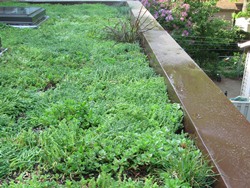
Our green roof, with sedums and a couple of annual grasses planted along the edge
Green roofs are getting more popular every year. City and even national governments are increasingly requiring green roof construction as part of commercial construction over a certain size.
Businesses are learning the value of green roofs to the corporate image as well as the ability of a green roof to lower building heating and cooling costs. Even homeowners are in on the game.
I became the proud owner of a green roof in the spring of 2012 – pictured at left – and what’s more, I put the green roof in myself – with help from my family and neighbors.
For anyone curious about what a green roof actually is, we can define a green roof as a roof where plants grow, typically in some kind of engineered soil or medium. The benefits of a green roof are many. To name just a few:
- The soil medium beneath the plants, and the plants themselves to a lesser extent, increase the insulation value of the roof slightly
- In hot weather, the natural transpiration of the plants as they photosynthesize produces a cooling effect, which reduces air conditioning costs in the space below
- The green roof provides habitat for indigenous plant species and arthropods (mine even provides acorn hiding spots for local squirrels)
- Where the green roof has footpaths or seating, it provides a haven from the hustle and bustle of the city
- If you plant fruits or vegetables in a green roof it becomes a source of locally-grown food.
- A green roof captures the water from heavy downpours and buffers its flow to sewers, reducing the risk of flooding, and in cases where the storm and sanitary sewers are combined, reducing the potential for raw sewage to overflow into waterways during a rain storm.
Green roofologists typically make the distinction between two different kinds of green roofs: intensive green roofs, which are built with a thick soil medium and can therefore accommodate a wide range of plants; and extensive green roofs, whose soil medium is thinner and therefore only supports very drought tolerant plants with shallow roof systems.
To those I would add a third type of green roof, the patio roof – a roof where people can visit, but where the majority of space is taken up by potted plants. While a patio green roof doesn’t provide as much insulation value, cooling value, habitat, or runoff control, it does offer something in these areas, is much cheaper to install, and for anyone with an existing flat roof, may be the only option given the load bearing capacity of the roof in question.
A note on retrofitting a green roof
If you are thinking about putting a green roof onto your existing home (or any other building you own, such as a cottage, shed, or commercial space), make sure you consult an engineer to ensure your building can support the load of the roof.
When we planned our ground floor renovation, we built the addition where the green roof now sits with more extensive structural support because we knew the green roof would need it. Instead of 2×10″ joists spaced 16″ apart, which would normally be sufficient for a flat roof in our snow-prone region given a 10′ joist span, we used 2×12″ joists spread 12″ apart. The headers supporting the joists were also spec’d by the engineer to support the load of a green roof.
If you install a green roof – especially an intensive green roof with its thicker soil medium – on a flat roof that was not built to support the weight, you are courting disaster.
Plants for green roofs
In general you want to strive for drought tolerant plants on a green roof, because the limited thickness of soil doesn’t provide much water storage capacity.
In gardens and lawns, plants can sink their roots down deep and extract moisture from deep in the subsoil during dry spells, and indeed some of the humidity from lower down rises as the soil above it dries out.
But on a green roof there is no subsoil, and nowhere for the roots to go below the medium, so you need to choose plants that can last at least a few days without natural rainfall. Either that or you need to set up an automated irrigation system to prevent the plants from drying out.
The plant genus of choice for green roofs is sedums. Sedums are succulent plants that grow naturally throughout the northern hemisphere. Many species grow very low to the ground in intense mats. Sedums can last weeks without water, overwinter well, blossom in a variety of colors and at different times, and can tolerate nutrient-poor soils (the engineered soil medium used for green roofs tends to be very low in nutrients).
Other favored plant types, especially for intensive green roofs where limits to root depth are less of an issue, include perennial grasses, and self-seeding annual wildflowers such as brown-eyed susans.
While drought tolerance is one key consideration in selecting plants for green roofs, another is heat tolerance: because green roofs are part of the built environment and typically have little shading from intense sunlight, they tend to get hotter than ground-level gardens.
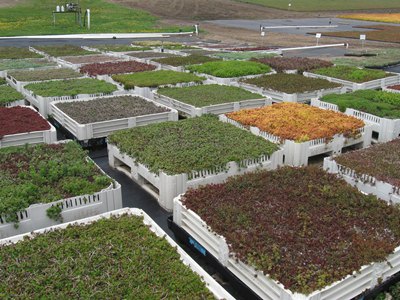
Sedum Master, the company we bought our green roof from, grows an ever increasing variety of sedums. These are their test plots, where they try out new varieties to see how they tolerate drought, how they fare in Ontario’s long, cold winters, and how vigorously they grow.
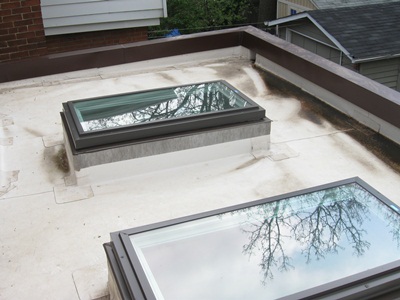
The flat roof on our dining room addition, with TPO waterproofing membrane. Popular choices for green roof membranes include asphalt roofs, EPDM membrane, and TPO membrane, which is a membrane fused together at the seams by intense heat. Drain is to the upper right.
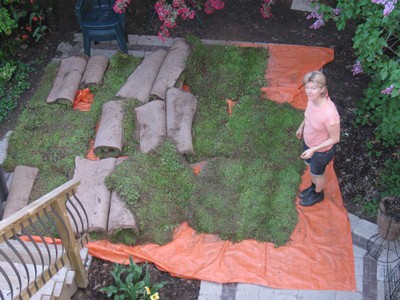
The sedums come in large rolled-up matts similar to sod. I had to carry them up the ladder in a canoe tripping portage pack because they were so heavy. Towards the end, once the main sections were in place, I cut pieces to the size I needed and could carry small sections up the ladder in one hand, while I held the ladder with the other.
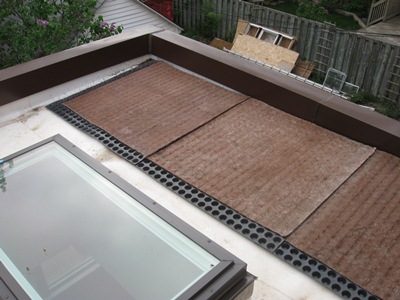
The substrate or matting consists of a plastic tray with cup indentations to hold water, and perforations between the cups to allow drainage, covered by a layer of fibrous material. We got these up onto the roof by carrying them to the upstairs bathroom and passing them out the window. When you install the substrate you overlap two rows of cups on two adjacent edges of each sheet.
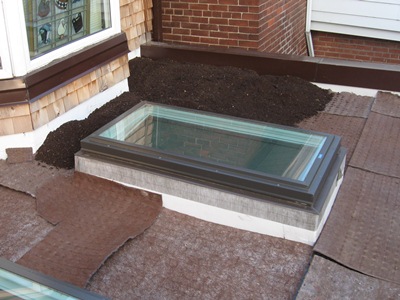
The growing medium consists of sand, crushed brick, pebbles, and a small percentage of organic matter. We lifted all this, bucket by bucket, on a rope. It was probably eight hours work just to get all the growing medium up onto the roof. I spread roughly 4 inches across the green roof.
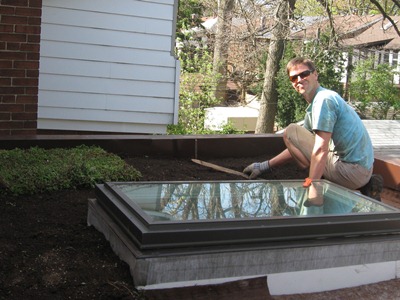
Once the growing medium is spread it needs to be levelled and tamped down. I should probably have spent more time on the tamping down – after installation it turned out things were not as even as I would have liked.
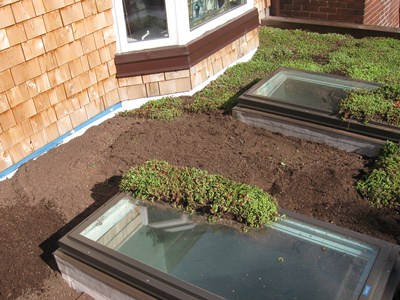
The sedums can be laid down very quickly, although the mats are tricky to cut because they have a heat-fused plastic mesh embedded in them to hold everything together. At first I thought we would run out of sedums, but that turned out to be an optical illusion: the sedum mats on the patio down below looked small because they were far away! By the end of the job we had enough left to install a few small clumps of sedums in our front garden.

Once completed, the green roof looks a little dry and you can clearly see gaps between sections of mat. A thorough watering every few days while the green roof establishes itself will help. Luckily for us we had a good dousing of rain two days after the roof went in.

Two weeks later, the green roof looked healthy and the gaps were already filling in; the sedums had already grown at least 2-3 inches. We also planted three perennial grasses along the west side of the roof (not shown in this picture); otherwise, from our garden there would be no sign of anything growing up there!
Problems with green roof installation
Two things I learned about green roofs that are very important: you need to ensure the roof is designed so that there are no standing pools of water, and you need to ensure your installer is very experienced with the materials used to build green roofs (again, TPO or EPDM).
I’m reasonably handy with architectural drawings (though not with architecture) so I had drawn up the plans for the renovation, including all the specifications. The design called for a level roof with a very slight pitch, parapet walls on the three sides that weren’t attached to the house, and a drain at one end. We decided on TPO as the material.
We had hired a contractor to do a full ground floor renovation, including the extension the green roof would be placed on, and the roofing. As with many contractors, this one inspired great confidence while cutting many corners during the construction. The first hint that things would not go well came when he assured me his team would be able to install the TPO material, because they had watched a video on it and knew where they could borrow the specialized tools needed to install it.
The second hint came when I arrived home one day from work to find that he had decided to install an asphalt and tar roof instead of the agreed-on TPO. He said he’d read up on these and both were very waterproof. I did some reasearch and determined that while both are very waterproof for ordinary flat roofs, asphalt and tar are absolutely not suitable for a green roof because they are not designed to be covered by heavy, wet materials for extensive periods. After a bit of back and forth, he agreed to install the TPO roof, and this was done a couple of weeks later.
The third hint was a wet area starting to appear above the exterior door to the addition. It turns out this was close to where the drain was that drained water to the downspout. This required me to remove the sedums from that area of the roof, the engineered soil, the mat and the plastic trays. After a rain I cold see what the problem was: the roof had not been built perfectly flat; there was a slight dip around the door, and water pooled there. There was also a seam in the TPO material, and clearly the seaming had not been done correctly.
This is one of the big challenges of a flat green roof – if you allow any water to pool, the tiniest pin prick in the material or imperfection in the seams will let water in. Since there’s no way for that water to evaporate, it accumulates, causing ever increasing damage to insulation, joists, the drywall underneath, and so on.
I started by trying to patch the TPO myself and putting the tray, mat, soil and sedums back on, and repairing the damaged drywall in the ceiling. A few months later I realized that hadn’t worked. Without removing the pooling area there was really no way to guarantee another leak wouldn’t develop.
The final solution was to hire a professional roofing company. I removed all the sedums, soil, matts and trays. Because the company wasn’t that good at managing their schedule, we were given a two month time window during which the reroofing could start at any time, so we had to have the roof clear at the start of that period. As you might expect, they showed up at the end.
They removed the TPO to start with, and that’s where the next disaster struck. Where the water had pooled, the fiberboard underneath had gotten wet. Where there’s wet wood, termites or carpenter ants follow, and we had a carpenter ant infestation. We had to hire an exterminator to come and spray the affected area. Fingers crossed that took care of the carpenter ants!
The roofers cut 2×4’s on the bias so that they formed very acute triangles; they nailed these to the existing plywood subroof so that the new roof would have a slope of about 3.5″ from top to bottom. They installed a new subroof over these mini-joists. They also removed the end parapet wall (the one opposite the house) so that the water could drain directly into an eavestrough rather than towards one drain hole in the roof. They used EPDM and installed it professionally – these guys actually had experience installing it and knew what they were doing.
The sedums were spread out in my back yard for the two months. They didn’t fare that well – there was a fair bit of die-back. Another backbreaking weekend getting all those material sand all that soil and sedum matting back on the roof! But by the next summer, the sedums had fully recovered, and there have been no signs of leaks in the ten years since!

Leave a Reply
Want to join the discussion?Feel free to contribute!